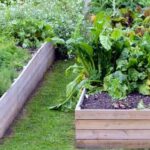Are you looking for a creative and efficient way to grow your own vegetables in South Africa? Vertical gardening may be the answer. In this article, we will explore the benefits, tips, expert advice, and success stories of vertical vegetable gardening in South Africa.
Vertical vegetable gardening is gaining popularity in South Africa as urban living becomes more prevalent. With limited space for traditional gardens, many people are turning to vertical gardening to grow their own fresh produce. Jane Griffiths, an expert on organic gardening in South Africa, has championed this sustainable and space-saving method of growing vegetables.
In this article, we will discuss the advantages of growing vertical vegetables in your South African garden. From maximizing space to improving air circulation and drainage, vertical gardening offers numerous benefits that can help you cultivate a thriving and productive garden. Whether you live in a bustling city or a rural area, vertical vegetable gardening can be a practical and rewarding solution for producing your own food.
Benefits of Growing Vertical Vegetables in Your South African Garden
Vertical gardening in South Africa offers many benefits for gardeners looking to make the most of limited space and challenging growing conditions. By growing vegetables vertically, you can maximize your available planting area, increase your crop yield, and overcome potential obstacles such as poor soil quality or limited sunlight. In addition to these practical benefits, vertical vegetable gardens can also add a visually appealing and unique element to your outdoor living space.
Maximizing Space
One of the most significant benefits of growing vertical vegetables in your South African garden is the ability to make the most of limited space. Whether you have a small backyard, balcony, or courtyard, vertical gardening allows you to grow a wide variety of vegetables without needing a large plot of land. This is especially advantageous in urban areas where traditional gardening space may be scarce.
Increased Crop Yield
Another benefit of vertical vegetable gardening in South Africa is the potential for increased crop yield. When you grow vegetables vertically, you can fit more plants into a given area than with traditional horizontal planting methods. This means that you can harvest a larger quantity of fresh produce from your garden, making it an efficient and rewarding way to cultivate your own food.
Visual Appeal
In addition to their practical advantages, vertical vegetable gardens can also enhance the visual appeal of your outdoor space. With careful planning and selection of plant varieties, you can create a lush and vibrant garden that adds beauty and interest to your surroundings.
Vertical gardens can be designed to serve as natural dividers or screens, adding privacy and creating a cozy atmosphere for outdoor gatherings. Overall, growing vertical vegetables in your South African garden not only provides numerous practical benefits but also contributes to the overall aesthetic appeal of your outdoor living area.
Tips for Choosing the Right Vegetables for Vertical Gardening in South Africa
When it comes to vertical vegetable gardening in South Africa, choosing the right vegetables is essential for a successful and bountiful harvest. There are several factors to consider when selecting which vegetables to grow in your vertical garden, including the climate, sunlight, and space available. Here are some tips for choosing the right vegetables for vertical gardening in South Africa:
1. Climate suitability: South Africa has diverse climates across its regions, from Mediterranean to subtropical and semi-arid. It’s important to choose vegetables that are well-suited to the specific climate of your area. Consider heat-tolerant varieties for warmer regions and cold-hardy vegetables for cooler areas.
2. Sunlight requirements: Determine the amount of sunlight your vertical garden receives throughout the day. Some vegetables thrive in full sun, while others prefer partial shade. Choose vegetables that align with the sunlight conditions of your vertical garden space.
3. Space-saving options: Since vertical gardening maximizes limited space, opt for vegetables that are well-suited for growing upwards. Vining plants like tomatoes, cucumbers, and pole beans are excellent choices for vertical gardens as they can be trained to climb trellises or support structures.
By considering these factors, you can select the most suitable vegetables for your vertical garden in South Africa and ensure a successful harvest year-round.
Additionally, it’s crucial to take into account the expert advice of Jane Griffiths when choosing vegetables for your vertical garden project in South Africa. Her insights on plant selection and care can be instrumental in creating a thriving vertical vegetable garden tailored to South African conditions.
The Expert’s Perspective
Jane Griffiths: A Pioneer in Vertical Vegetable Gardening
Jane Griffiths is a well-known name in the world of gardening, particularly in South Africa. She is the author of the popular book “Jane’s Delicious Garden” and has been instrumental in promoting sustainable and organic gardening practices in the country. Her expertise and passion for gardening make her the perfect person to turn to for advice on vertical vegetable gardening.
Key Insights From Jane Griffiths
According to Jane Griffiths, vertical vegetable gardening offers numerous benefits for South African gardeners. Not only does it maximize limited space, but it also provides better air circulation and sunlight exposure for plants. Additionally, she emphasizes that vertical gardens can be arranged creatively, adding visual appeal to outdoor spaces.
Moreover, Jane advises aspiring vertical gardeners to select vegetables that are well-suited for this growing method. Vining plants such as tomatoes, cucumbers, and beans thrive in vertical environments and can yield abundant harvests when properly tended to. With her extensive knowledge on the subject, Jane Griffiths serves as an invaluable resource for anyone looking to venture into vertical vegetable gardening in South Africa.
Guidance From Jane Griffiths
For those interested in embracing vertical vegetable gardening, Jane Griffiths suggests providing sturdy support structures such as trellises or mesh netting for climbing plants. Additionally, she recommends using quality soil that is rich in nutrients to promote healthy growth. By following her guidance, gardeners can set themselves up for success when embarking on their own vertical gardening journey.
Step-by-Step Guide to Setting Up a Vertical Vegetable Garden in South Africa
Vertical gardening in South Africa can be an efficient and space-saving way to grow vegetables, especially for those with limited garden space. With the right setup and care, you can enjoy a bountiful harvest of fresh produce in your own backyard. To help you get started, here is a step-by-step guide to setting up a vertical vegetable garden in South Africa.
First, choose a suitable location for your vertical garden. Look for a spot that receives plenty of sunlight throughout the day, as most vegetables require at least six hours of sunlight to thrive. Next, assess the available space and decide on the type of vertical garden structure that will work best for your needs. Options include wall-mounted planters, freestanding towers, or even repurposed items such as pallets or gutters.
Once you have selected a location and determined the type of structure you will use, it’s time to prepare the soil and choose your vegetables. Use a high-quality potting mix that is well-draining and rich in organic matter. When selecting vegetables for your vertical garden, consider the climate and growing conditions in South Africa. Opt for varieties that are well-suited to your region and will thrive in a vertical environment.
After preparing the soil and choosing your vegetables, it’s time to plant your vertical garden. Follow spacing guidelines provided on seed packets or plant tags, and be mindful of how plants will grow vertically as they mature. Water newly planted vegetables thoroughly and monitor moisture levels regularly, as vertical gardens may dry out more quickly than traditional gardens.
With steps like these for setting up a vertical vegetable garden from Jane Griffiths advice from her book “Jane’s Delicious Garden”, gardening South Africa enthusiasts will benefit greatly from fresh home-grown produce even with limited space.Additionally,jane griffiths has some additional advice about controlling pests within this type of garden due to her extensive experience in gardening.” It’s important to keep an eye out for pests,”Jane notes.
“Regular monitoring can help you identify any issues early on so you can take action before they become a bigger problem”.
Maintenance Tips for Vertical Vegetable Gardens in South Africa
Vertical vegetable gardens require regular maintenance to ensure the health and longevity of your plants. Here are some essential maintenance tips for vertical vegetable gardens in South Africa:
1. Watering: Proper watering is crucial for vertical vegetable gardens, especially in South Africa’s hot climate. Be sure to water your plants regularly, paying special attention to those at the top of the vertical structure, as they may dry out faster.
2. Pruning and Training: Keep an eye on the growth of your vegetables and prune or train them as needed. This will help maintain a compact and tidy appearance, as well as encourage healthy growth.
3. Fertilizing: Vertical gardens can benefit from regular fertilization, especially in nutrient-poor soils. Consider using organic fertilizers to promote healthy growth without harming the environment.
4. Pest and Disease Management: Regularly inspect your plants for any signs of pests or disease, and take appropriate action to address any issues that arise. Utilize natural methods of pest control whenever possible to avoid harming beneficial insects or pollinators.
5. Support and Structural Maintenance: It’s important to regularly check the supports and structures of your vertical garden to ensure they remain stable and secure. This is especially crucial during strong winds or storms.
By following these maintenance tips, you can help ensure the success of your vertical vegetable garden in South Africa, allowing you to enjoy a bountiful harvest throughout the growing season while minimizing potential issues that may arise.
Overcoming Challenges in Vertical Vegetable Gardening in South Africa
Vertical vegetable gardening in South Africa comes with its own set of challenges, but with the right knowledge and preparation, these challenges can be overcome. One common challenge is the unpredictable weather, which can include both extreme heat and unexpected cold snaps. To combat this, it’s essential to choose vegetables that are well-suited to the local climate and to ensure that your vertical garden receives the appropriate amount of sunlight and watering.
Another challenge in South Africa is the presence of pests such as aphids, whiteflies, and caterpillars that can wreak havoc on vegetable plants. However, by regularly inspecting your vertical garden for signs of infestation and using natural remedies or pesticides when necessary, you can prevent these pests from damaging your crops.
Additionally, limited space in urban areas can also pose a challenge for vertical vegetable gardening in South Africa. Many people living in cities have small outdoor spaces or only have access to balconies for gardening. However, with the use of creative solutions such as wall-mounted planters, hanging baskets, or trellises, even those with minimal space can enjoy a thriving vertical vegetable garden.
| Challenge | Solution |
|---|---|
| Unpredictable Weather | Choose climate-appropriate vegetables; provide adequate sunlight and watering |
| Pests | Regular inspection; use natural remedies or pesticides when necessary |
| Limited Space | Use wall-mounted planters, hanging baskets, or trellises for small outdoor spaces or balconies |
By addressing these challenges through proper planning and proactive measures, individuals throughout South Africa can successfully cultivate vibrant and productive vertical vegetable gardens – enriching their lives and contributing to the overall sustainability of their communities.
Success Stories
Vertical vegetable gardening in South Africa has been gaining popularity in recent years, with many enthusiasts achieving great success in their gardening endeavors. One inspiring example is a community garden in Johannesburg, where a group of residents came together to transform an unused wall into a thriving vertical vegetable garden. By utilizing limited space and implementing sustainable gardening practices, they were able to grow a variety of vegetables such as tomatoes, peppers, and leafy greens.
Another success story comes from Durban, where a school implemented a vertical gardening project to not only provide fresh produce for the school cafeteria but also as an educational tool for the students. The project not only taught the children about the importance of sustainable food production but also instilled a sense of responsibility and pride as they tended to the vertical garden.
In Cape Town, a rooftop garden has become a symbol of urban sustainability, showcasing the potential of vertical vegetable gardening in an urban setting. The garden utilizes innovative irrigation techniques and creative use of space to grow an abundance of vegetables while contributing to greening efforts in the city.
These success stories serve as inspiration for many aspiring vertical vegetable gardeners in South Africa, demonstrating that with dedication and creativity, it is possible to cultivate thriving gardens even in limited spaces.
| Vertical Garden Success Story | Location |
|---|---|
| Community Wall Garden | Johannesburg |
| School Vertical Garden Project | Durban |
| Rooftop Urban Garden | Cape Town |
Conclusion
In conclusion, embracing vertical vegetable gardening in South Africa is not only a sustainable and efficient way to grow your own produce, but it also contributes to a greener and more eco-friendly environment. With the expert guidance of Jane Griffiths and the numerous benefits of growing vertical vegetables, South Africans have the opportunity to make a positive impact on their communities and the planet as a whole.
Vertical gardening offers an innovative solution for urban dwellers or those with limited space to still enjoy the satisfaction of growing their own fresh produce. By utilizing this method, individuals can also save money on grocery bills while reducing their carbon footprint. Additionally, choosing the right vegetables for vertical gardening in South Africa ensures that you can create a colorful and diverse array of plants that will thrive in your specific climate and conditions.
As we continue to navigate the challenges of food security and environmental sustainability, vertical vegetable gardening stands out as an accessible and impactful solution for South Africans. By incorporating the step-by-step guide provided in this article and learning from success stories across the country, gardeners can inspire others to join them in embracing this efficient method of cultivation.
Ultimately, through education, advocacy, and hands-on experience with vertical vegetable gardening, we can all contribute to a healthier and more sustainable South Africa.
Frequently Asked Questions
What Vegetables Grow Well in Vertical Gardens?
Vegetables that grow well in vertical gardens include leafy greens like lettuce, spinach, and kale, as well as compact plants like tomatoes, peppers, and herbs. These plants are well-suited for the limited space and vertical growing conditions of a vertical garden.
How Do You Set Up a Vertical Vegetable Garden?
Setting up a vertical vegetable garden involves choosing a sunny location, installing a sturdy trellis or vertical structure, preparing the soil with adequate drainage, and selecting the right vegetables for vertical growth. It’s important to water regularly and provide proper support for climbing plants.
What Is the Fastest Growing Vegetables in South Africa?
In South Africa, some of the fastest growing vegetables include spinach, Swiss chard, radishes, and green beans. These vegetables thrive in South Africa’s climate and can be grown relatively quickly from seed to harvest, making them popular choices for home gardeners and farmers alike.

If you’re looking to get into vegetable gardening, or are just looking for some tips on how to make your current garden better, then you’ve come to the right place! My name is Ethel and I have been gardening for years. In this blog, I’m going to share with you some of my best tips on how to create a successful vegetable garden.





